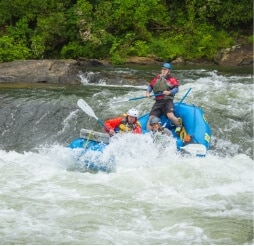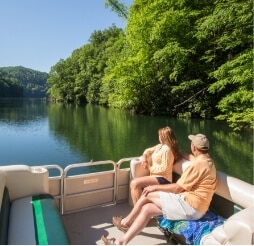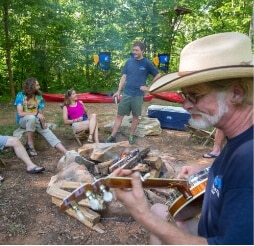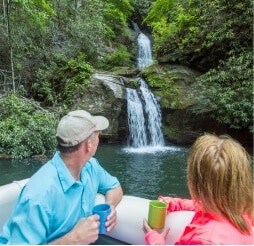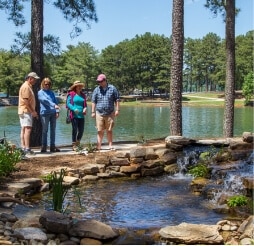Brooks Wade, of Jocassee Lake Tours, discusses one of his favorite animals: the Common Loon
A Lot to Like About Loons
Why does he like loons so much? Because they engage people more than other birds. Their calls are enticing; they are very cooperative and are not afraid of people.
The common loon is an ancient bird that looks the same today as it did thousands of years ago. They are known as “common” because they are so widespread. They breed across the top of the world from Alaska to Siberia.
Loons in Oconee County
The Common Loons we see in this area are approximately 2 1/2′ to 3′ wide. Their bodies are very dense and are designed for diving deep in the water to catch fish. They can dive up to 200 feet deep and stay underwater for 5 minutes. They have the least amount of wing surface to body weight of any bird. They have a short wingspan and can’t glide like other birds. Their legs are positioned towards their tail underneath their bodies, and they are not able to support their weight to walk on land. They look like a “flurry of energy” when they fly and need a great deal of space to get airborne.
Seasonal Color Highlights
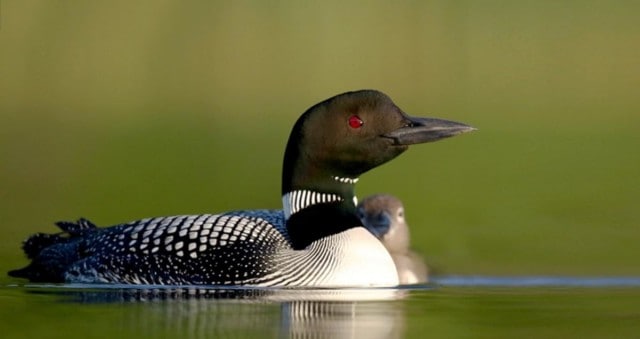 Loon coloring is remarkable. During the winter months, they are a uniform grey color because there’s no need to be “sexy” during this time. In January, they shed all of their flight feathers and cannot fly for 4-6 weeks. In February, they start molting into their summer look. They go from grey to their spectacular summer coloring. In their summer glory, loons become very pretty, dotted with white speckled patterns that help them attract mates. In March, their hormones start raging, and loons become more aggressive in preparation for breeding. A mass migration occurs in April.
Loon coloring is remarkable. During the winter months, they are a uniform grey color because there’s no need to be “sexy” during this time. In January, they shed all of their flight feathers and cannot fly for 4-6 weeks. In February, they start molting into their summer look. They go from grey to their spectacular summer coloring. In their summer glory, loons become very pretty, dotted with white speckled patterns that help them attract mates. In March, their hormones start raging, and loons become more aggressive in preparation for breeding. A mass migration occurs in April.
Loon Migration
Loons migrate 2,000 miles from their freshwater breeding grounds in the upper midwestern U.S. down to the marine environments in the Gulf of Mexico and Florida. During their migration, loons stop to overwinter on Lake Jocassee. This occurs from late October through March. Known to be site loyal, loons have been genetically designed to return to the same spot each season. Once they land, they don’t fly again until it’s time to leave in April. The same group of birds stays together; they huddle up and sleep in the middle of the lake away from the shore. They eat baitfish and crustaceans.
Relative to their history, it is a new phenomenon for loons to overwinter on freshwater lakes in the southeast. This is likely due to the fact that man-made lakes are a modern development, that has resulted in new site grounds for loons. Lake Jocassee was completed in 1973 and is one of the newest reservoirs in the southeastern region. At any given time, there are 100-150 Common Loons on Lake Jocassee. During the winter, we see an influx of loons stopping over to rest and prepare for the next journey on their southern migration.
Loon Research on Lake Jocassee
Lake Jocassee is situated in Upstate South Carolina. It’s a wilderness reservoir fed by four mountain rivers and dozens of creeks. The lake is about 9,000 acres and has 90 miles of shoreline. Loons are fairly easy to spot on the lake and Lake Jocassee’s small area makes it navigable and ideal for studying loons.
Jocassee Wild Outdoor Education, along with Jocassee Lake Tours, will host a volunteer study programs to research loon activity on Lake Jocassee. The programs are intended to help scientists study the health and behavior of Common Loons wintering in a freshwater ecosystem. The results of the research will be used to raise awareness about the importance of lake reservoirs as a habitat for loons and other waterbirds, and how to best monitor and manage them
Winter Research Opportunity
February 26 – March 4, 2023
March 5 – March 11, 2023
Winter Loon research has taken place on Lake Jocassee for the past six years. Dr. Jay Mager will return for his 4th year as lead investigator. 12 volunteers are needed for week-long stays at Devils Fork State Park to help observe, record and band loons. You can expect to witness molting, preening and bathing, group foraging and departure behaviors.
Spring Research Opportunity
March 26 – April 1, 2023
In 2022, loon research expanded to include the study of Common Loons during spring migration. The research continues this Spring with Dr. James Paruk as lead investigator. A unique week-long experience for 12 volunteers. This is distinctly different week in the field where volunteers can expect to witness the departure of hundreds of loons as they leave Lake Jocassee on their migration.
Learn more about the 2023 Loon Research on Lake Jocassee along with details and costs associated with the program.
- Tags: Discover Oconee, Lakes, Nature
-
Post Author: Ken Sloan


